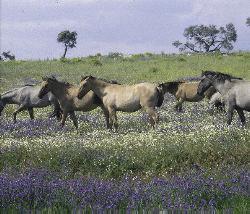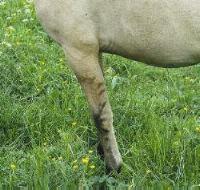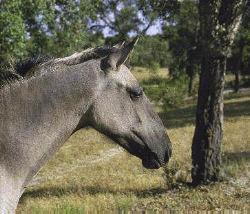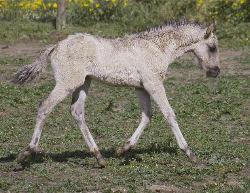|
|
The Sorraia
The Sorraia horse is a primitive horse of South
Iberia, not a breed for all we know, but a subspecies. Its discoverer, the
Portuguese scientist Ruy d'Andrade, believed it to be a direct descendant of an
Iberian wild horse, and the main ancestor of the Andalusian, Lusitano, and Barb
horses. Horses of Sorraia type were depicted in prehistoric cave paintings in
South Iberia, like the one in Escoural (Portugal) and La Pileta (Spain).
The wild
horse of (southern) Iberia has been described by contemporary chroniclers as of
the color of a donkey, i.e. grulla (mouse-dun), the color prevailing among
Sorraias.
Photo right:
The Sorraia's colour is always either dun
(yellowish with dorsal stripe and leg stripes) or grulla (mouse coloured with
dorsal stripes and leg stripes). |

Photography by Hardy Oelke |
Sorraias are always either grulla or dun in color,
a dilution color pattern with a dark dorsal stripe (eel stripe), leg stripes,
often also shoulder stripes; "cobwebbing" patterns on the forehead;
stripes on the neck and back are also sometimes present
. They are normally of a
fairly light shade of dun or grulla. One characteristic feature is their dark,
"sooty" faces - in contrast to other primitive horses like the Exmoor
and Mongolian wild horse, which have mealy mouths and lighter areas around the
eyes.
Characteristically, the mane and tail are
bi-colored - the dark or black middle part is fringed by light-colored, often
nearly white, hair.
|

Leg stripes on a dun Sorraia.
Photography by Hardy Oelke |
The Sorraia typically stands around 14 to 14.2
hh, sometimes more. By contrast, the Garrano, a primitive Iberian pony found in
the mountains in the north of Iberia, is typically around 12 to 12,3 hh in
size. It is also brown or bay in color and of different conformation.

Very typical head of a young Sorraia mare, showing
the convex profile, but also the overall refinement
Photography by Hardy Oelke |
A very
obvious characteristic for the Sorraia is the convex head profile, sometimes
called a Roman head, or a ram head. This type of head has always been typical
for the Iberian saddle horse, and only recently did a certain influence of
Arabian horses result in different profiles in a number of horses. |
The Roman, or convex, head must not be confused
with a Roman nose. Horses can have a straight profile or even show a dish
somewhere in their profile and may still have a Roman nose. This is usually
found in coarse horses of draft horse descend. The Sorraia's profile is convex
from poll to nostrils and at the same time the head is a refined one.
Sorraias are of refined, slender, leggy build,
with narrow heads, narrow chests, prominent withers, rather straight backs of
medium length, and a rafter-shaped hip. The hip usually slants at a nice angle,
suitable for a riding horse, with a medium tail set. A steeply dropping hip and
really low tail set would be atypical.
Sorraias are extremely limber and flexible,
both laterally and vertically. The same horse that walks strung-out and looks
like having an almost horizontal croup and high tail set may in the next
instant collect himself and round his back and suddenly appear to have a
sloping croup and low tail set.
Due to rather long cannon bones, the action of
the Sorraia is fairly high, with considerable knee action.
Sorraias have traditionally been tamed and used
as mounts, especially for herdsmen. In spite of being a primitive horse, the
Sorraia, once tamed, is very suitable for riding, Due to its slender neck of
sufficient length and clean throatlatch, the horse finds it easy to flex at the
poll, its general agility and balance enables it to move in a collected way.
According to Ruy d'Andrade, most, if not all, modern saddle horse breeds owe
their suitability for dressage to this primitive ancestor.
It is not uncommon for Sorraias to be gaited.
 |
This Sorraia baby filly already
shows the movement and conformation traits that make the Sorraia a horse, not a
pony, in spite of its medium size of about 14 to 14.3 hands: well set, slender
neck, ability to flex at the poll (this baby carries itself like it was in the
bridle!), legs of good length, free shoulders which allow free swinging strides
and balance, with an active rear end.
Photography by Hardy Oelke |
|

